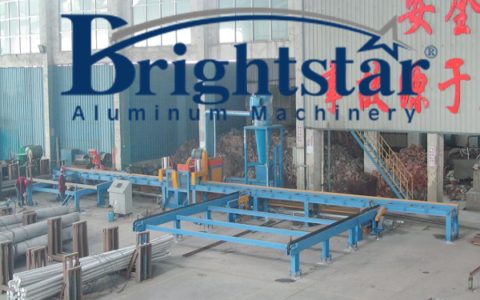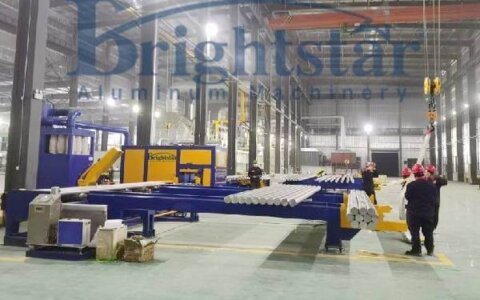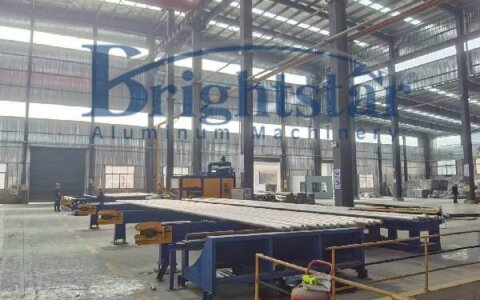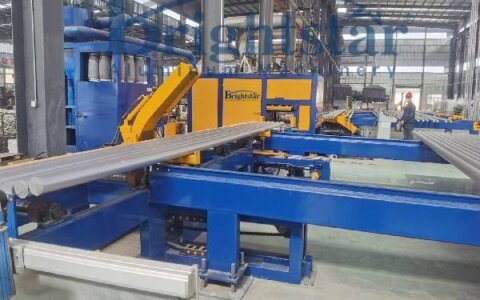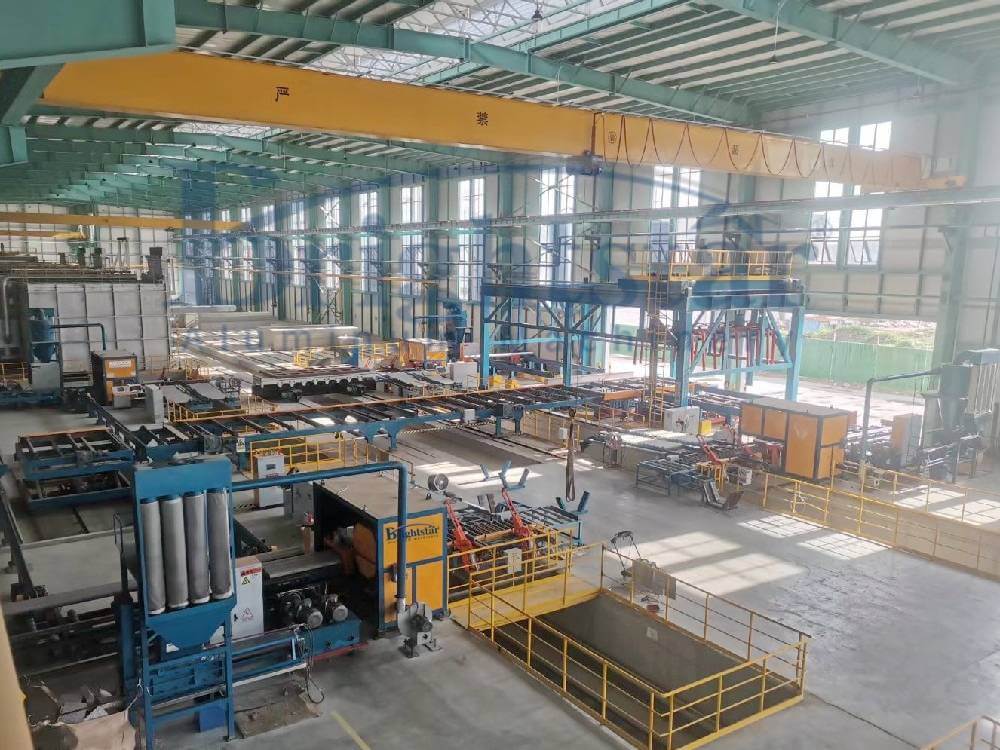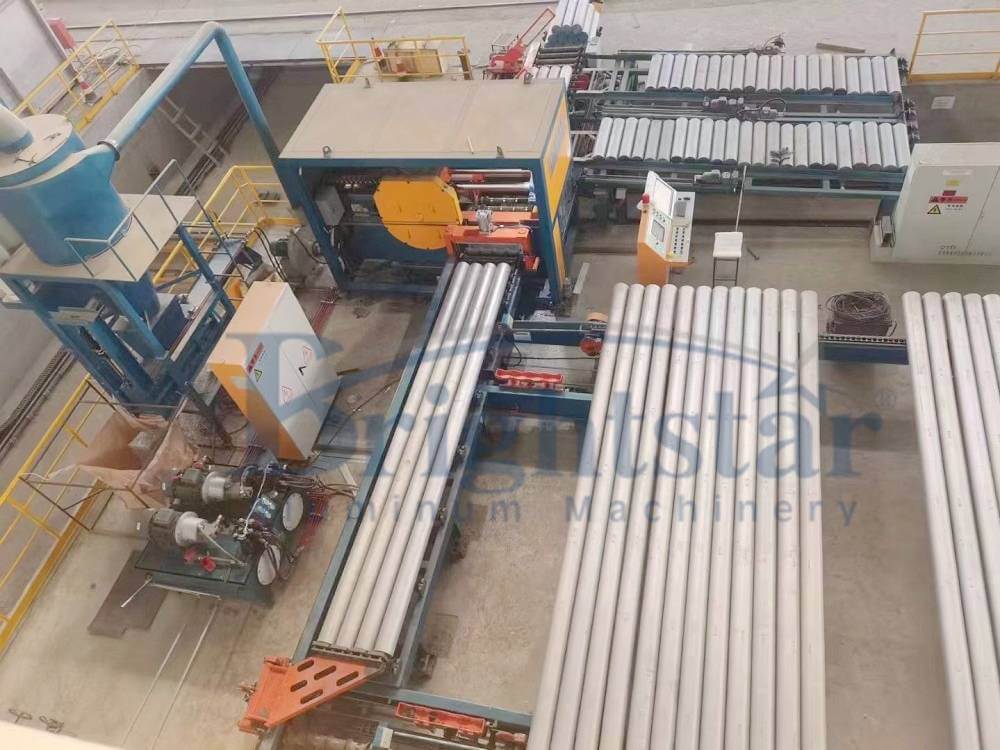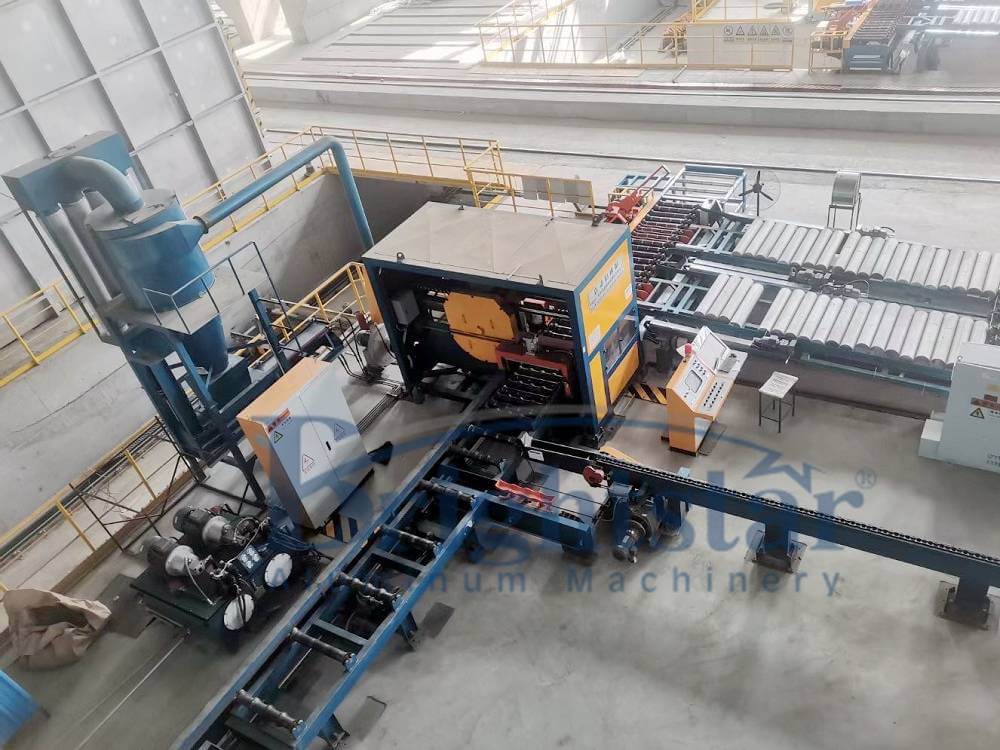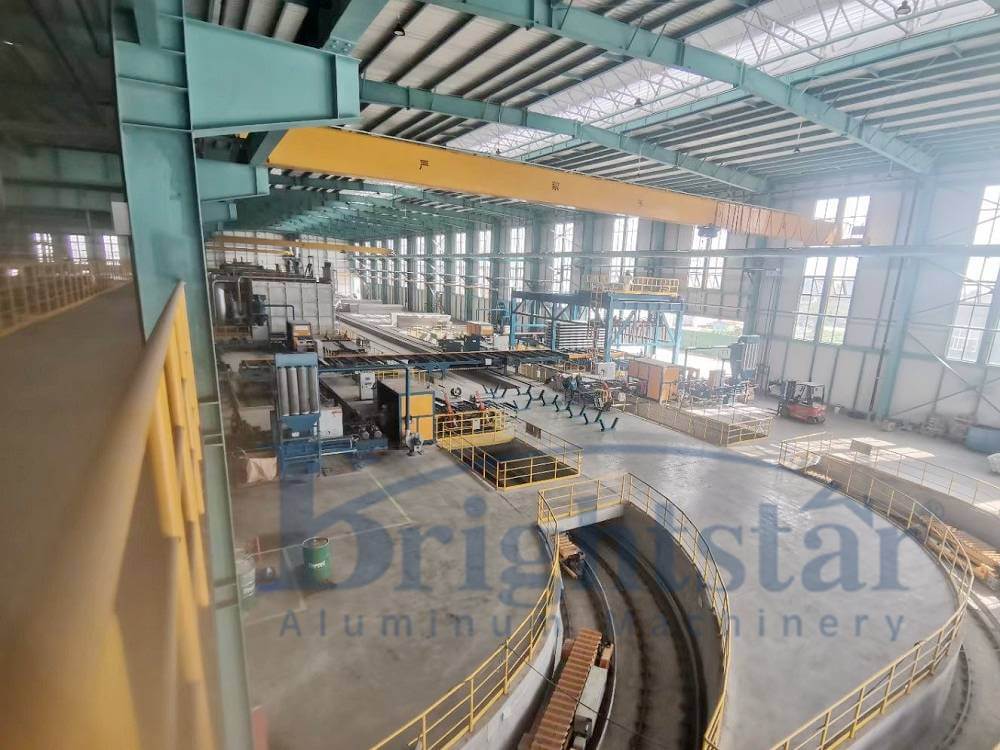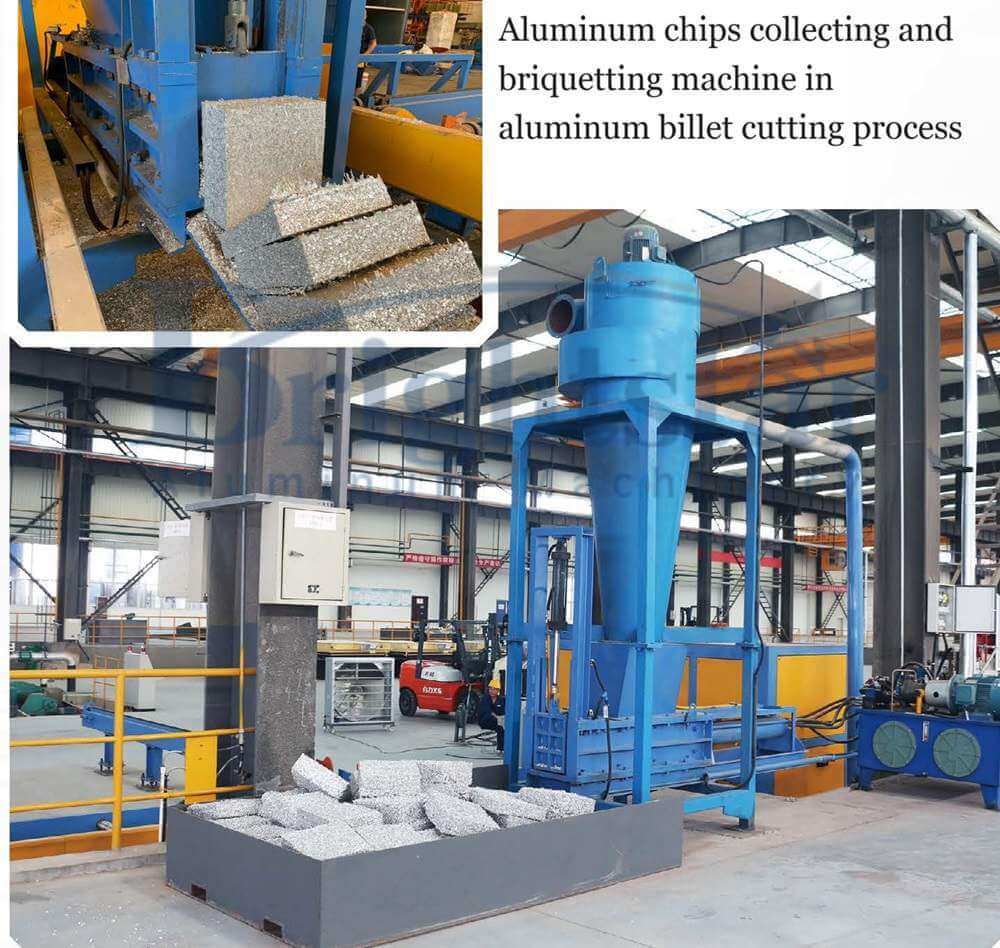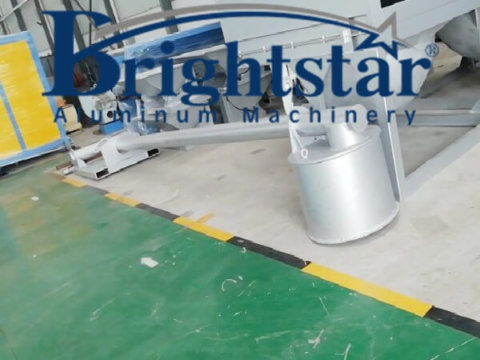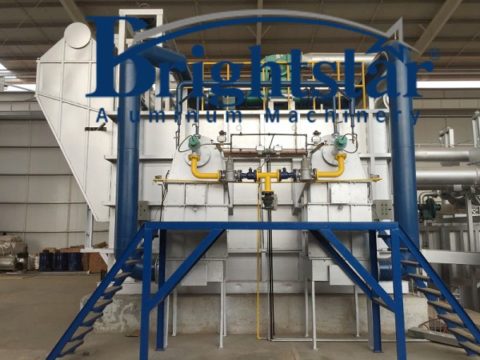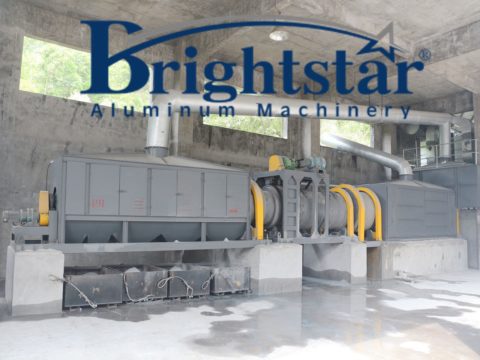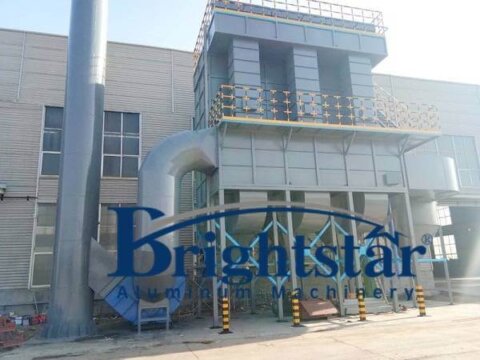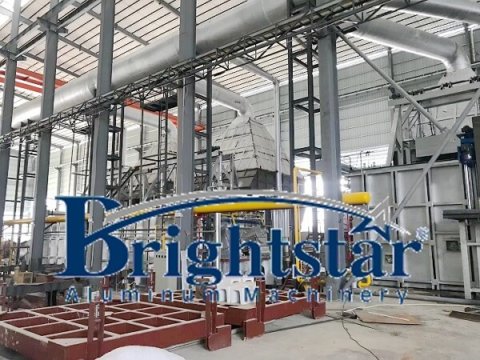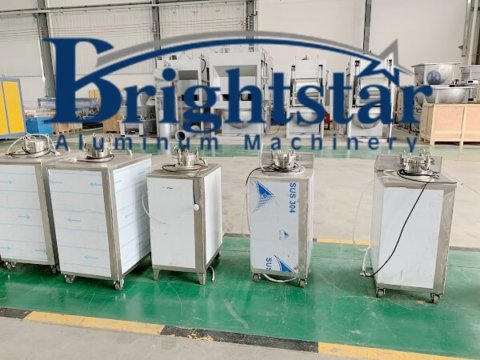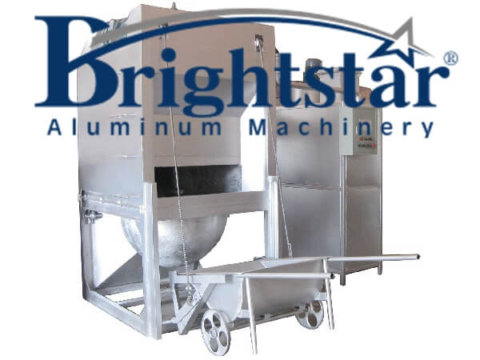
Aluminium billet multi billets saw
Aluminium billet multi billets saw
Aluminium billet multi billets saw
While a single billet cutting saw excels at the precise cutting of individual billets, an aluminum billet multi-billets saw takes efficiency to the next level by simultaneously cutting multiple billets for short billets or both ends.
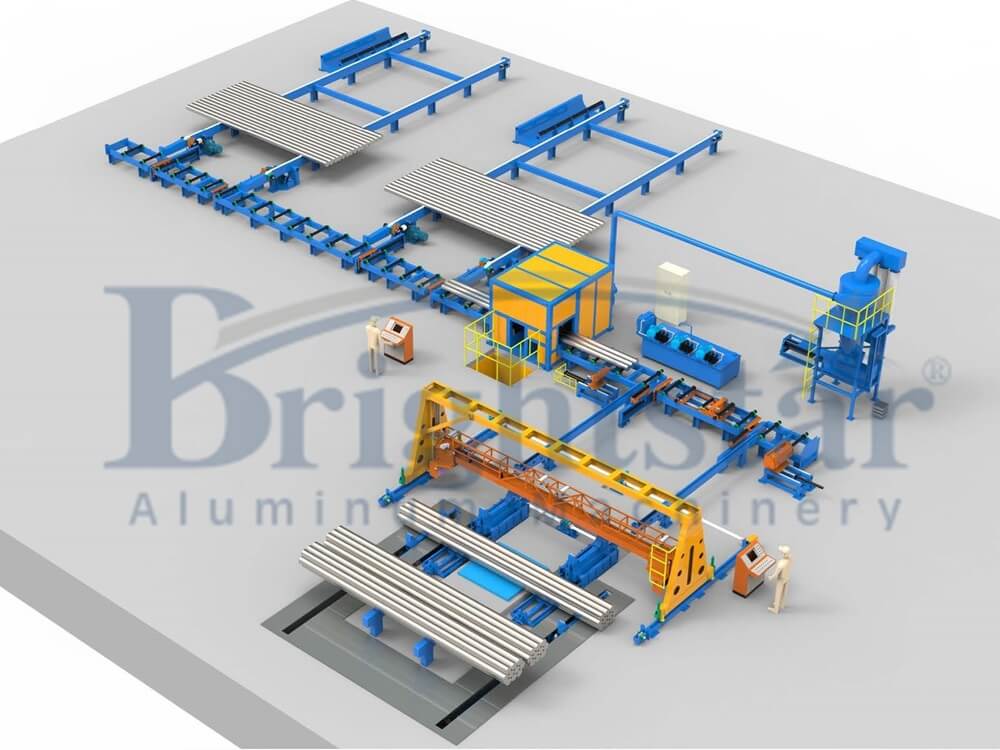
Aluminum billet cutting saw system design for multi billets
This specialized saw offers significant advantages for high-volume production and specific applications.
5″(127.00mm),6″(152.40mm),7″(177.80mm),8″(203.20mm) aluminium billet multi billets cutting system
Aluminium billets multi billets saw a brief introduction
Semi-automatic and automatic aluminum billets cutting saw can achieve automatic feeding on the conveyor, automatic roller feeding, cut to length, pressing aluminum billets, saw blade sawing and material delivery, finished billets under the conveyor, sawing at the same time pumping aluminum chips into the vacuum cleaner and baling action.
The machine is simple, and can cut multiple billets at one time.
Can be made the design according to customer requirements. It is featured with safe and practical, high production efficiency.
Function:
1. Billet loading: The aluminum extrusion or ingot is positioned and securely clamped on the saw bed.
2. Precise positioning: Advanced control systems and guides ensure the saw blades align with the desired cut locations for each billet.
3. Simultaneous cutting: Multiple high-speed saw blades, typically arranged in a gang fashion, simultaneously cut through the aluminum, creating individual billets in one pass.
4. Ejection and handling: The severed billets are ejected from the saw and transferred to the next stage of processing via conveyors or rollers.
Key Features:
High cutting efficiency: Simultaneous cutting of multiple billets significantly increases production output compared to single billet saws.
Flexible configuration: Some models offer adjustable blade spacing and blade counts to accommodate different billet sizes and production requirements.
Automated operation: Modern saws feature automatic loading, positioning, and cutting processes for maximum efficiency and operator safety.
Optimized blade technology: Special blade designs and materials ensure clean cuts with minimal burrs and surface imperfections.
Advanced control systems: Precise control over blade speeds, feed rates, and cutting angles ensure consistent and accurate results.
Advantages:
Drastically increased production capacity: Cutting multiple billets at once can double or even triple production output compared to single billet saws, ideal for high-volume operations.
Reduced labor costs: Automated operation minimizes manual labor requirements, leading to cost savings and improved safety.
Material optimization: Multi-billets saws can often yield more billets from the same extrusion or ingot compared to single saws, optimizing material utilization.
Versatility: Some models can also be used for single billet cutting, offering flexibility for diverse production needs.
Reduced setup time: Pre-configured blade spacing and automated functions allow for quick changeovers between different billet sizes, minimizing downtime.
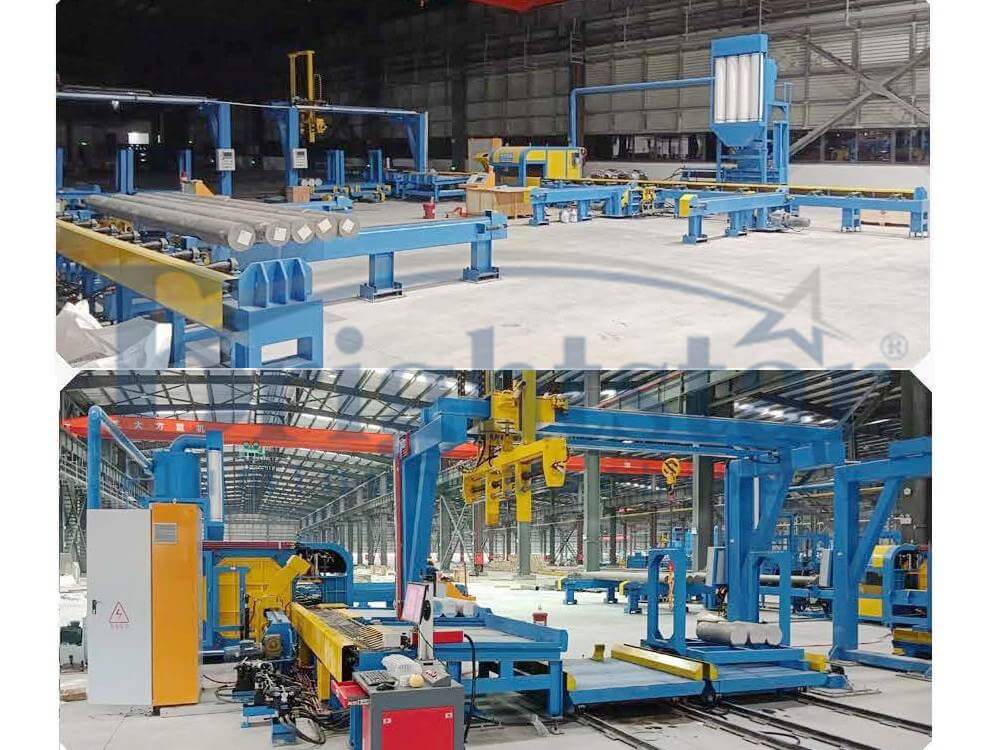
Multi billets aluminum billet cutting saw system project
Applications:
High-volume production of standard-sized aluminum billets for extrusion, forging, and rolling processes.
Cutting aluminum extrusions into smaller billets for specific applications.
Efficient processing of long aluminum ingots or extrusions into multiple billets.
In conclusion, an aluminum billet multi-billets saw is a powerful tool for maximizing production efficiency, particularly in high-volume settings.
Its ability to simultaneously cut multiple billets with precision and minimal waste makes it a valuable investment for manufacturers seeking to optimize their aluminum processing operations.
However, it’s important to consider the specific production needs and billet sizes before implementing this saw, as its cost and complexity might not be suitable for every situation.
Aluminium billets cutting saw working principle
The machine is made up a loading rack, conveying roller, saw table, pressing framework, cut-to-length framework, discharging framework, hydraulic station and electrical control system Etc parts.
The main action is hydraulic drive, PLC operation, stable performance.
Original aluminum billets→electrical operation→Automatic loading→cut to length→ pressing aluminum billets tightly →cutting(chips recovery and baling)→finished products conveying→release pressing→aluminum billets unloading→ automatically→ re conveying (another circle)
Aluminium billets saw processing procedure
First, start the hydraulic system, start the aluminum chip recovery motor and start the saw blade main motor standby, according to the length of the cut aluminum billet to adjust the fixed position, and then start the following steps:
→ 1 hanging the billets from the well, placed directly on the auxiliary putter, from the auxiliary frame, use of crane, put aluminum billets in the row in the large chain translation device, the storage frame chain can be transported to the front of the conveyor near the positioning, read for loading;
→ 2 by the hydraulic drive (translation car) jack some pieces original aluminum billets and translating to the conveyor side, put down the aluminum billets at conveyor roller, return to the original place and standby;
→ 3 aluminum billets into the roller, the transmission power roller fast rotation, transport aluminum billets;
→ 4 the plate in the front of the saw head jack-up, the material end to the saw blade about 100mm or so, the ends are even, the transmission power roller stop the rotation, the pressing device press billets for cutting ;
→ 5 Saw blade rotation in uniform speed, saw blade cylinder to promote the saw, (at this time the blade feed speed can be stepless speed, depending on the billets size adjustment speed), spray cooling device start, start sawing, start aluminum chips recycling;
→ 6 Automatic sawing finish, the saw blade motor back to the saw, spray stopped, the billets end in the sawing when the continuous fall into the waste box;
→ 7 Saw blade back to place, billet pressing device release billets;
→ 8 The feed roller fast rotation, while the robot arm in the ruler put down cut to length device;
→ 9 Before Billets get near to gauge stop, the transmission of the power roller slowly forward until it gets to the cut-to-length block, transport power roller stop rotating;
→ 10 Saw blade cylinder saw blade for finished product sawing (at this time saw blade feed speed can be stepless speed, depending on the billet material size adjustment speed), billets ends waste continuously fall off the waste box when cutting, spray cooling device start, while chipping recovery on;
→ 11 sawing, gauge table robot arm up;
→ 12 automatic sawing finish, the gauge side pressing device release the billets, the roller fast rotation, spray stop;
→ 13 finished billets sent by discharge roller to the hydraulic transmission device (translation car), then jack up pieces finished aluminum billets out of the conveyor to the finished product storage rack, the transmission device finish the work and back to the finished product conveyor standby, By the crane or forklift to achieve the stack of finished billets
→ 14 While the saw blade back to place, the entire sawing cycle finish, move to the next sawing cycle.
(Note: aluminum chips recovered in each sawing, hydraulic baler baling and discharge out of machine.)
We make the project design based on your production situation.
Not only provide the machine and equipment but also offer aluminum billets cutting solutions!
Pros of Multi-Billets Saws:
Increased Efficiency: Simultaneously cutting multiple billets significantly boosts production, ideal for high-volume settings.
Reduced Labor Costs: Automation minimizes manual work, improving safety and potentially lowering labor expenses.
Material Optimization: Multi-saws can sometimes yield more billets from the same material, reducing waste and maximizing utilization.
Versatility: Some models can switch between multi and single cutting, offering flexibility for diverse needs.
Safety Considerations:
Always prioritize safety: Regardless of the saw type, following proper safety protocols, wearing appropriate personal protective equipment, and adhering to manufacturer guidelines is crucial.
Automated systems: While automation reduces manual handling, it doesn’t eliminate risk. Stay vigilant and never reach into the cutting zone while the saw is operating.
Blade maintenance: Regularly inspect and maintain blades to ensure optimal performance and minimize the risk of accidents.
Choosing the Right Saw:
Assess your production needs: Consider volume, billet sizes, and budget before deciding.
Consult with experts: Talk to manufacturers and industry professionals for tailored advice.
Prioritize safety: Never compromise safety for efficiency. Choose a saw that meets all necessary safety standards and complements your specific workflow.
Remember, the best saw is the one that safely and efficiently meets your unique aluminum billet cutting requirements.
Contact us now for your aluminum billets project! Total solution and turnkey project!
The aluminum billet saw for cutting aluminum logs produced by our company is divided into two categories:
Aluminum billet single billet saw and aluminum billet multi-billets saw.
When further subdivided, it can be divided into online aluminum billet saws, offline aluminum billet saw, long billet aluminum billet saw and short billet aluminum billet saw.
The online aluminum billet saw is directly matched with the billet heating furnace or other auxiliary equipment.
After sawing the round log according to the length requirements, they are transported or stored with other equipment (billet furnace or mechanical clamp).
The offline aluminum billet saw is an aluminum billet saw that cuts round logs independently without supporting other equipment or production lines.
Sawing and bundling according to length requirements.
As the name suggests, the long billet aluminum billet saw means cutting the finished billet into a long billet.
As the name suggests, a short aluminum billet saw means cutting the finished billet into a short billet.
Introduction to various configuration accessories: (Follow the aluminum billet walking process)
1. Auxiliary unloading billet holder:
The aluminum billet is hoisted from the casting well in an upright state.
The semi-circular arc guide plate in the auxiliary billet unloading holder contacts the bottom end of the aluminum billet.
The crane descends, and the rollers assist in sliding, thereby placing the aluminum billet from the upright state to the horizontal state, and transporting it in a large shift area.
When workers use forklifts to transport aluminum billets to large shift areas, this auxiliary unloading billet holder is not needed.
2. Large shift area:
The motor reducer drives the chain to travel, and the chain travel transports the aluminum billets to the aluminum billets turning and counting area, and the automatic aluminum billets counting device places the aluminum billets in the original billets storage area to wait for loading.
3. Small shift and billet loading of raw aluminum billet:
The aluminum billets are sent to the original billets’ conveyor frame by the front and rear lifting of the oil cylinder.
4. Raw aluminum billets feeding into the billet conveyor:
An oil motor is used to drive the sprocket chain to drive the rollers to transport the aluminum billets.
5 Aluminum billet saw:
The main motor drives the saw blade to run.
The oil cylinder drives forward and backward walking sawing.
With front and back ends billet pressing devices.
6. Length-fixing device:
Enter the parameters of the finished aluminum billet to automatically determine the length of the aluminum billets before sawing.
7. Finished aluminum billet conveyor frame:
Conveying aluminum billets after sawing is completed.
8. Finished aluminum billet lifting and unloading device:
The aluminum billets in the finished product conveyor frame are pushed out of the conveyor frame employing cylinder jacking.
The jacking method can be divided into two types.
One is the air cylinder, and the other is the oil cylinder.
For example: in the case of an aluminum billet multi-billet saw where the finished billet is 6 meters, the air cylinder jacking method is used for aluminum billet below φ254
The oil cylinder jacking method is used for aluminum billets above φ254.
Analyze specific situations in detail.
9. Finished aluminum billet storage rack:
Used to store finished aluminum billets for easy operation by customers.
They can be lifted manually or forklifted.
10. Lubricate the oil spray device:
Use vegetable lubricant to cool and lubricate the saw blade.
11. Aluminum chips recycling device:
Collecting and briquetting aluminum chips when sawing aluminum billets.
12. Hydraulic control system:
Including hydraulic station, oil pipes in the equipment, valve groups, etc.
Cooling methods are divided into water cooling and air cooling.
(Note: Hydraulic oil is excluded and it will be offered by the customer)
13. Electrical control system:
Including 1 operation cabinet, 1 electrical cabinet, wires in the equipment, a transfer cabinet, various induction switches, etc.
The electrical components are mainly Siemens low voltage.
The customer is responsible for connecting the power supply to the electrical cabinet.
Note: All the above machine parts constitute a general aluminum billet saw system.
The following is a brief introduction to advanced configuration accessories that meet various customer requirements:
1.Aluminum chip briquetting machine:
Equipped with aluminum chip recovery device, used to press aluminum chips into blocks for easy recycling.
2. Briquetting block conveyor:
Conveys the briquettes after the aluminum chips come out of the briquette machine.
(Note: Generally, not required.)
3. Aluminum billets coding device:
Coding types include needle pinhole coding and laser coding.
You can type letters and numbers when coding.
Laser coding can print QR codes.
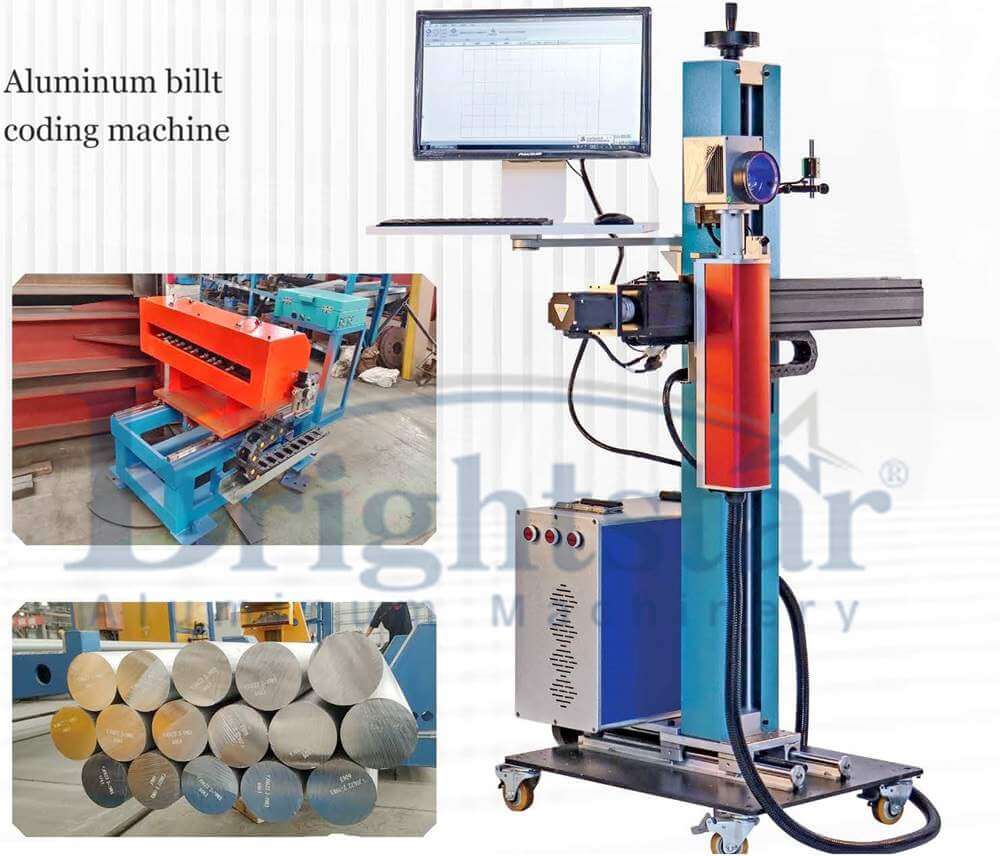
Aluminum billets coding machine
If an aluminum billet coding device is used, the finished billet lifting and unloading device must be changed to a small shift of the finished billet, which is the same as the small shift parameters and working mode of the original billet.
(Note: Excessive coding content affects overall efficiency.)
4. Hydraulic billet aligning device:
Placed behind the finished billet storage rack, the billets are released through the cylinder, and the aluminum billets slide down to the V-shaped frame according to gravity.
There is a hydraulic cylinder on the side to push the end faces of the aluminum billets into alignment.
Stack the aluminum billets into a trapezoid (manual assistance is required). Manual baling.
(Note: Customers who sell aluminum billets may need it.)
5. Gantry stacking system:
Placed behind the finished billets rack, it is lifted and lowered by the oil cylinder, aluminum billet is clamped by the oil cylinder, and the oil motor is started to move forward and backward.
Place the aluminum billets on the V-frame and stack them into a trapezoid
(No manual assistance required). Manual baling.
The V-shaped frame can be equipped with a floor scale to calculate the weight of the stack of aluminum billets
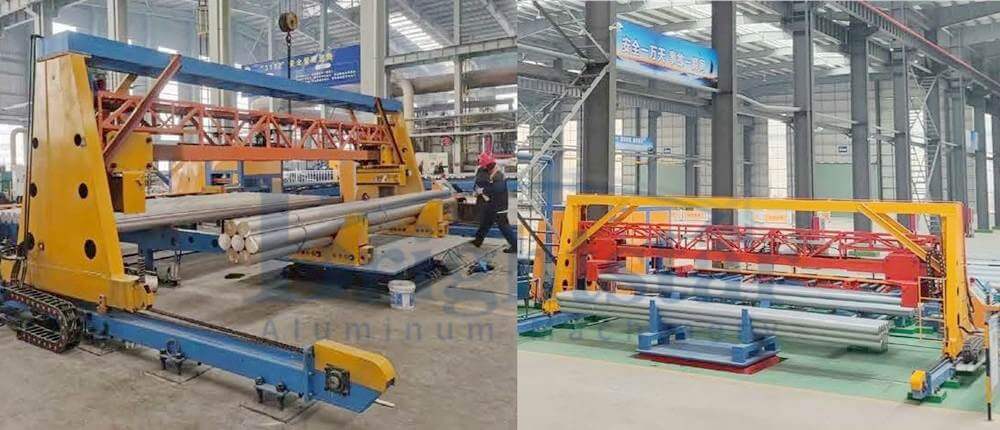
Long-length aluminum billet stacking system
Common knowledge points about aluminum billets saw for cutting aluminum log:
1. Regarding the size of the saw blade: (under normal circumstances)
According to the φ80-229 aluminum billet, the saw blade is φ800.
According to φ80-254 aluminum billet, the saw blade is φ900.
According to the φ80-300 aluminum billet, the saw blade is φ1000.
According to the φ80-320 aluminum billet, the saw blade is φ1100.
Note: If there is a non-standard aluminum billet, it is φ260. We can also use 900 saw blades for design.
After analyzing the specific situation, it is correct to follow the above rules.
2. Regarding the external conditions for aluminum billets saws:
Power supply: Under normal circumstances, if the equipment is close to the upright column, the main electrical cabinet can be connected to the main electrical cabinet through the column.
The customer is responsible for the external power supply of the equipment, and our company is responsible for the wires inside the equipment.
Water source: The water used by the equipment lies in the cooling of the hydraulic station.
When there is no shortage of water abroad, water cooling is the main method. Cheaper and better than air-cooled ones.
For foreign customers, use water cooling and air cooling together. (Need to state in advance).
Air source: Mainly pipeline air, requiring an anhydrous state, otherwise the cylinder will be easily corroded.
Hydraulic oil: Hydraulic oil is 46# anti-wear and pressure-resistant. Normally 4-5 barrels of 170kg are needed.
Analyze specific situations in detail.
Tools: Our company will deliver a set of special tools and will give them to customers after installation.
However, welding machines, welding rods, gas, gas cutting tools, etc. are all provided by the customer.
On-site installation: whether the customer makes embedded parts according to the drawings or concrete anchor.
When making embedded parts, the equipment legs are welded on top, which is stronger than the concrete anchor.
Customers with concrete anchors need to check the screws regularly.
Network: Foreign customers need to offer network cable.
Regarding the number of large shift areas: Under normal circumstances: 2 sets for 6 meters and 3 sets for 12 meters.
Foreign customers have 4-meter and 6-meter raw aluminum billets, which are also 3 sets.
Analyze specific situations in detail.
The small shift of the raw aluminum billet is adjusted according to the number of large shift.
